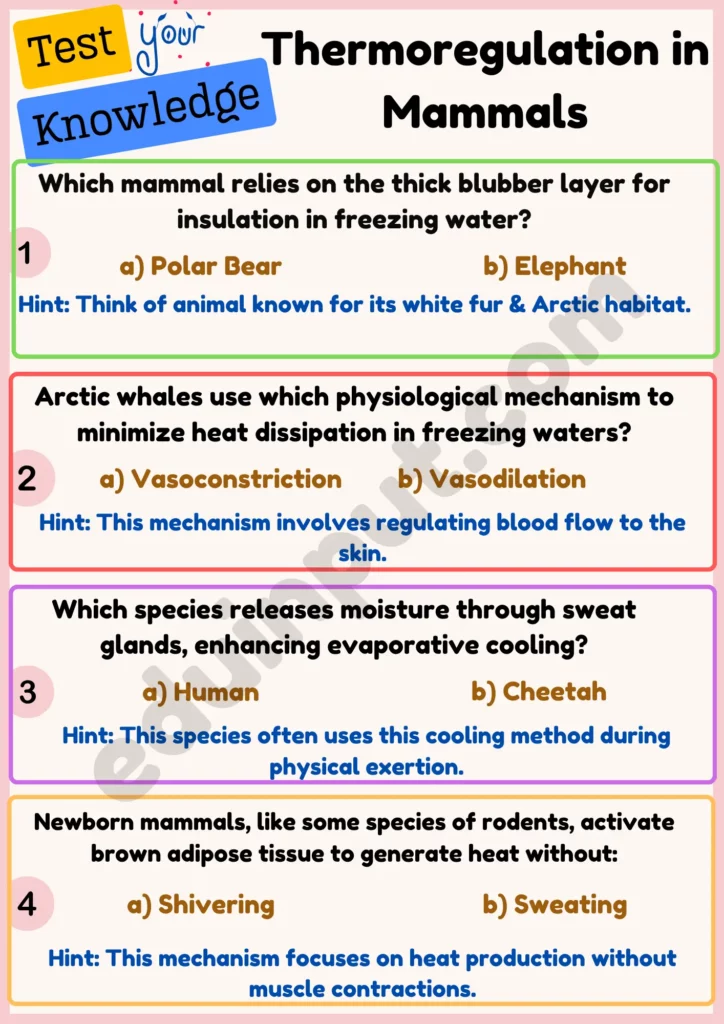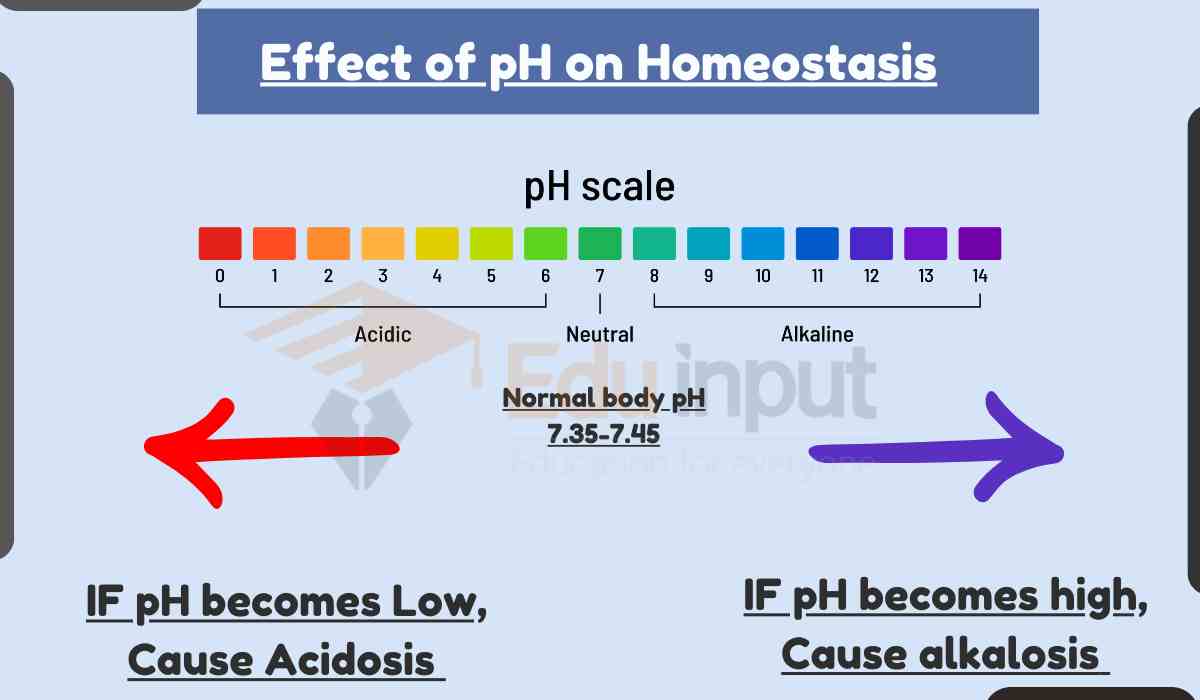Thermoregulation in Mammals-Physiological and Behavioral Mechanisms & Their Limitations
Mammals regulate temperature through a combination of thermoregulatory heat loss and heat production behaviors. Heat loss mechanisms include vasodilation (widening of blood vessels), panting, and sweating, which help release excess heat.
On the other hand, heat production behaviors involve vasoconstriction (narrowing of blood vessels), shivering, breakdown of brown adipose tissue, and huddling to generate and conserve heat when needed.
Thermoregulation strategies in Mammals
Mammals use various thermoregulation strategies to maintain a stable internal body temperature, essential for optimal physiological function. These strategies can be broadly categorized into heat loss and heat production mechanisms.
These mechanisms are influenced by external environmental factors like air temperature, humidity, and wind. Different mammal species have also evolved adaptions to suit the thermoregulatory demands of their natural habitats and lifestyles.
Read Detailed Overview of Adaptations in Mammals for Thermoragulation
For example, polar bears utilize thick fur and blubber for insulation in frigid climates.
The hypothalamus region of the brain acts as a “thermostat” by constantly monitoring internal and external cues and initiating thermoregulatory responses in order to keep body temperature within a narrow optimal range.
Heat Loss Mechanisms
- Vasodilation: Widening of blood vessels near the skin surface facilitates increased blood flow, promoting heat dissipation. For example, dogs rely on vasodilation and panting to prevent overheating during strenuous exercise.
- Panting: Rapid breathing helps release excess heat through evaporation of moisture from the respiratory surfaces, particularly in species lacking sweat glands.
- Sweating: Some mammals, such as humans and horses, release moisture through sweat glands on the skin, which enhances evaporative cooling.
Heat Production Mechanisms
- Vasoconstriction: Constriction of blood vessels minimizes blood flow to the skin, reducing heat loss in colder environments. For instance, arctic whales prevent body heat dissipation by huddling together.
- Shivering: Involuntary muscle contractions generate heat, aiding in raising body temperature.
- Brown Adipose Tissue (BAT) Activation: Brown fat, rich in mitochondria, can be metabolized to produce heat without shivering, particularly in newborns and hibernating mammals.
- Huddling: Grouping with conspecifics or seeking shelter helps to conserve heat by reducing exposure to the external environment.

Physiological Mechanisms of Thermoregulation in Mammals
Here is an expanded draft with each mechanism as a heading and more detail:
1. Insulation
Mammals have various forms of insulation that limit heat exchange with the environment, conserving body heat in cold conditions and limiting heat gain in hot conditions. These include:
- Body hair – The fur or hair coat traps air close to the body to reduce convection and conduction. Mammals will fluff up their fur to increase the thickness of the trapped insulating air layer when ambient temperatures drop.
- Fat layers – Adipose fat tissue under the skin and around organs act as insulation. Some mammals seasonally increase fat accumulation to limit heat loss through the winter. The thick blubber layer in marine mammals also conserves heat in freezing water.
2. Vasoconstriction and Vasodilation
Altering blood flow close to the surface of the skin and extremities is an important physiological mechanism for thermoregulation.
- Vasoconstriction – Constricting blood vessels reduces flow to skin. It minimizes heat transfer to the external environment. This prevents excessive heat loss in cold conditions. Arctic whales use vasoconstriction to minimize heat dissipation in freezing waters.
- Vasodilation – Dilation of surface blood vessels maximizes blood flow and heat transfer to skin, facilitating heat loss to the environment. This helps prevent overheating in hot ambient temperatures. Dogs rely on vasodilation and panting to prevent overheating during strenuous exercise.
3. Sweating
Sweat glands allow evaporative cooling through water loss at the skin surface. As sweat evaporates, it pulls heat away from the body. Areas with high sweat gland concentration like the palms and armpits are especially effective for heat loss.
Increased sweat production matched with vasodilation helps minimize heat gain during hot weather or strenuous activity.
Humans and horses release moisture through sweat glands on the skin, enhancing evaporative cooling.
4. Shivering
Involuntary muscle contractions generate heat during periods of cold exposure through cellular metabolism. Shivering quickly elevates metabolic rate and heat production as a temporary mechanism until chemical thermoregulation can activate. It tends to occur in short bursts between periods of muscle relaxation.
Animals like rodents shiver to generate heat and maintain body temperature in cold environments.
5. Non-shivering Thermogenesis
In brown adipose tissue, a special protein called thermogenin faciliates metabolic heat production without shivering. It offers superior temperature regulation in hibernating mammals and helps maintain body temperature in small mammals and newborns.
Newborn mammals, like some species of rodents, activate brown adipose tissue to generate heat without shivering.

Behavioral Mechanisms of Thermoregulation in Mammals
Along with physiological thermoregulation, mammals also use behavioral mechanisms:
1. Burrowing
Many small mammals create underground burrows and tunnels to avoid extreme ambient temperatures. Burrowing allows them to move into cooler soil layers during hot weather while the relatively stable underground temperature protects them from winter cold and wind.
Desert rodents burrow to escape the intense heat during the day.
2. Huddling
Social mammals will gather in groups or “huddle” during periods of cold exposure. Grouping reduces the total surface area exposed to the elements and allows sharing of body heat produced by individuals in the center of the group.
Emperor penguins huddle together to conserve warmth in the harsh Antarctic environment.
3. Basking
Basking involves positioning the body to maximize surface exposure to solar or thermal radiation from surrounding hot objects. Turning towards the sun or sprawling out facilitates heat gain during cold periods.
Lizards bask in the sun to raise their body temperature and increase activity.
4. Shade seeking
During hot weather, mammals avoid direct sunlight by seeking shade under trees, rocks or underground. This simple behavior minimizes radiant heat gain from the sun and facilitates cooling.
Elephants seek shade under trees to avoid overheating in the hot African savannah.
Limitations of Theroregulation Mechanisms and Need of Combined Response
While mammals have evolved various mechanisms for thermoregulation, each strategy comes with its limitations. That’s why they need for combined responses to effectively deal with diverse environmental challenges.
1. Sweating
- Limitation: Reduced effectiveness in high humidity.
- Combined Response: Humans in tropical climates often combine sweating with behaviors like seeking shade or using fans. The additional cooling mechanisms complement sweating in humid conditions.
2. Vasodilation
- Limitation: Excessive heat loss and dehydration in extremely hot conditions.
- Combined Response: Desert-dwelling animals, like the Fennec Fox, combine vasodilation with behaviors such as burrowing during the day and minimizing physical activity to prevent excessive heat loss and dehydration.
3. Insulation (Fur or Hair)
- Limitation: Overheating in warm environments.
- Combined Response: Arctic foxes change their fur color in summer, shedding the thicker insulating layer to prevent overheating. This adaptive response complements insulation with seasonal adjustments.
4. Shivering
- Limitation: Unsustainable for extended periods.
- Combined Response: Small mammals, such as the European Common Shrew, combine shivering with behaviors like seeking warm shelter to maintain body temperature during periods of cold exposure.
5. Non-shivering Thermogenesis (BAT Activation)
- Limitation: Limited heat production in certain conditions.
- Combined Response: Hibernating animals, like the Arctic Ground Squirrel, combine BAT activation with behaviors such as huddling in nests to maximize heat retention during torpor.
6. Behavioral Strategies
- Limitation: Infeasible or risky in some environments.
- Combined Response: Meerkats in the savannah combine vigilant sentry duty with burrow utilization. This behavior ensures effective thermoregulation while minimizing the risks associated with predation.
7. Heterothermy
- Limitation: Impact on prolonged metabolic processes.
- Combined Response: Bats that undergo daily torpor combine heterothermy with energy-efficient roost selection and adjusting flight patterns. This integrated approach helps balance energy conservation with thermoregulation.
8. Specialized Appendages (Ears)
- Limitation: Vulnerability to injury or predation.
- Combined Response: Elephants, with their large ears, combine this feature with behaviors such as shade-seeking and mud-bathing to enhance cooling. The combination minimizes risks associated with their specialized appendages.
Also Read:
Frequently Asked Questions-FQs
How do mammals thermoregulate?
Mammals thermoregulate through
Shivering thermogenesis
Non- shivering thermogenesis
Brown fats
Evaporative cooling
How do mammals thermoregulate in cold temperatures?
Mammals use following mechanisms to thermoregulate in cold temperature;
Vasoconstriction
Fur
Fats
Blubber
What is vasoconstriction?
The process of narrowing blood vessels in order to prevent heat loss by decreasing blood flow.






Leave a Reply